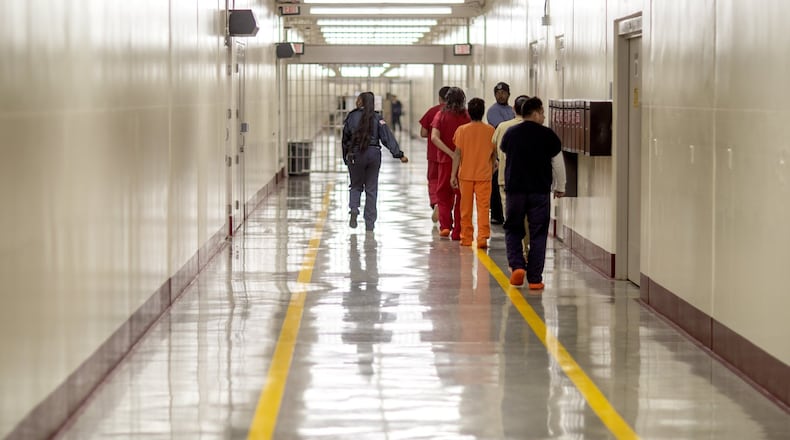The federal government paid a Georgia immigrant detention center more than $12.5 million for unused bed space over a year during the pandemic, according to an internal investigation that included a surprise visit to the Stewart Detention Center in South Georgia.
That revelation was part of a recently published report by the U.S. Department of Homeland Security’s Office of Inspector General.
Federal officials also found problems with migrants’ ability to access medical care and file grievances with the jail’s staff, “compromising the health, safety, and rights of detainees.”
Stewart is the state’s largest immigrant detention center and had previously drawn criticism from inspectors over safety issues. During the pandemic, it emerged as one of the deadliest Immigration and Customs Enforcement facilities, with four detainees dying of COVID-19-related illness.
According to the inspector general, Stewart’s medical unit ignored many requests for routine medical care, with only about 50% of ‘sick calls’ being honored. Staff shortages also led to prolonged delays in detainees’ ability to access mental health services.
Further, Stewart was found to have a deficient grievance process. Staff not only failed to acknowledge or respond to formal grievances, but they also made it difficult for detainees with limited English skills to file complaints in the first place. Inspectors also found instances of “commingling” between low-custody and high-custody detainees, a violation of ICE detention standards.
Despite those issues, the government subsidized the privately-run detention center to the tune of millions of dollars. During a recent calendar year, ICE paid $12.6 million for beds that went unused to CoreCivic, the company contracted to run Stewart.
The agency guaranteed payment for 1,600 detainees per day at a fixed, daily rate of $67.68 per bed.
But during a one-year timeframe from November 2021 to November 2022, Stewart’s daily population was nowhere near the 1,600-threshold, averaging just over 1,000 instead. That meant that the federal government had to pay CoreCivic millions to cover the cost of roughly 600 empty beds every day.
ICE representatives have previously argued that the use of guaranteed minimums helps the government negotiate a lower rate per detainee.
In its report about Stewart, the Office of the Inspector recommended ICE “review and update” its contract with CoreCivic and determine whether guaranteed minimums are necessary. ICE’s response to that suggestion, included in the report, stated that capacity was reduced during inspectors’ visit because of COVID-related measures, and that it was “currently in the process of moving [Stewart’s] capacity back to pre-pandemic levels and working toward meeting its guaranteed minimum.”
In an email to The Atlanta Journal-Constitution, CoreCivic referenced COVID’s impact on Stewart’s population levels when the federal inspection was performed. A company representative noted that the inspectors’ recommendations to healthcare-related issues were implemented.
But although COVID restrictions were lifted back in May, Stewart’s average daily population has only gone up to 1,224 as of Sept. 24, still short of the 1,600 guaranteed minimum. That’s according to Syracuse University’s Transactional Records Access Clearinghouse (TRAC).
Federal money being directed to empty immigrant jail beds is a national issue.
Earlier this year, another inspector general report found that ICE paid over $8 million for detention beds that went unused in a facility in Louisiana.
According to a 2021 analysis by the U.S. Government Accountability Office, the immigration enforcement agency was shelling out more than $20 million a month nationwide for empty beds in mid-2020. The number of guaranteed beds in ICE’s detention system expanded by 45% during the Trump administration.
“Planning for detention space needs can be challenging, according to ICE officials, because the agency must respond to factors that are dynamic and difficult to predict,” the GAO study notes. “A strategic approach to using guaranteed minimums could help position ICE to balance these factors and make more effective use of federal funds.”
Although it has yet to follow-up on a campaign promise to stop using private facilities for detention, the Biden administration has put greater emphasis on digital surveillance programs to monitor migrants ahead of court dates.
In the South Georgia city of Lumpkin, near Stewart, Amilcar Valencia runs El Refugio, a nonprofit that supports immigrant detainees. He is unconvinced that inspectors’ visits to the detention facility actually result in substantive changes.
“Conditions didn’t change after previous OIG reports and they certainly haven’t changed since the most recent one,” he said in a statement. “Advocates have called for a complete shutdown of this facility due to the record of human rights violations and to prevent people from living in unsafe and inhumane conditions.”
The Atlanta Journal-Constitution and Report for America are partnering to add more journalists to cover topics important to our community. Please help us fund this important work at ajc.com/give
About the Author
Keep Reading
The Latest
Featured



